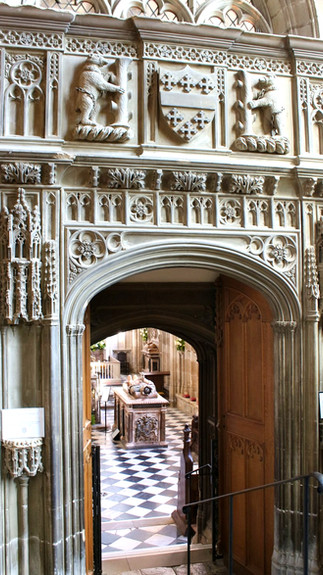The Noble Tombs of St Mary's Church
- Shannon
- May 17
- 5 min read
Updated: Jul 24
St Mary’s Church in Warwick, England, is a stunning example of medieval architecture with a history stretching back nearly 900 years. Founded in 1123AD by Roger de Beaumont, the 2nd Earl of Warwick, it was built on the site of an earlier Anglo-Saxon church and quickly became a powerful religious and political hub.

The interior of St Mary’s Church in Warwick is a fine example of Gothic architecture, full of intricate details and a sense of reverence. The church features bronze tombs with finely detailed effigies of knights and nobles, their serene faces reflecting the dignity of past generations. The walls are adorned with alabaster angels and polished marble tombs line the church, each with beautifully carved inscriptions honouring important figures from Warwick’s history. The stained glass windows depict various biblical scenes and saints, with vibrant colours and detailed designs showcasing key moments from the life of Christ and significant figures in Christian history.

The Beauchamp Chapel inside St Mary’s Church is a stunning 15th-century Gothic masterpiece, built to honour Richard Beauchamp, the 13th Earl of Warwick, whose richly decorated bronze effigy rests at its centre. His tomb, surrounded by intricately carved mourners and angels, is considered one of the finest medieval monuments in England. The chapel was intended as both a shrine and a statement of power and its ornate beauty contrasts with the darker legends of curses and hauntings that linger around it.

Also interred in the chapel are Robert Dudley, the 1st Earl of Leicester, buried alongside his wife Lettice Knollys and his brother Ambrose Dudley, Earl of Warwick. Their alabaster effigies line the walls, creating a space heavy with noble legacy. A smaller, poignant effigy of a child, likely a young member of the Beauchamp or Neville families, lies nearby, often the source of ghost stories involving phantom giggles or the soft sound of crying. The chapel is both a work of art and a mausoleum of Warwick’s elite, layered with history and grief.

Fulke Greville, 1st Baron Brooke, was a nobleman, poet and courtier who lived a life of influence under Queen Elizabeth I and King James I, only to meet a violent and tragic end. In 1628, he was stabbed by his trusted servant reportedly over a dispute about Greville’s will. The attack didn’t kill him immediately, he lingered in agony for several days before dying from infected wounds. He was buried in a sombre black tomb in the Chapter House of St Mary’s Church in Warwick. Unlike the ornate effigies of the Beauchamps, his monument is stark and austere, fitting for a man whose life ended in betrayal.
Beneath the grandeur of the nave and chapels of St Mary’s lies a darker, more mysterious world, a network of vaults, crypts and sealed chambers that hold the forgotten dead. Largely closed to the public and shrouded in mystery, the crypts are believed to hold the remains of lesser known medieval nobles, monks, priests and even plague victims. Many were buried close to the altar for spiritual prestige, though not all were commemorated with tombs or effigies. During the 16th century Reformation (a time of major theological movement in Western Christianity that posed a religious & political challenge to the papacy & the authority of the Catholic Church), burial records were lost and some vaults were sealed without documentation. Restoration work in the 19th century revealed partial remains, hinting at the presence of unmarked and forgotten dead still lying undisturbed beneath the church to this day, in the darkness below.

The Doom painting in St Mary’s is a striking and unusual feature, especially for a chantry chapel. Completed around 1634, it is believed to have been inspired by Michelangelo’s Last Judgement in the Sistine Chapel. The painting depicts the final judgement, with figures rendered in lifelike proportions, showcasing a shift from earlier medieval styles. Unlike the flat depictions of the past, this artwork incorporates a sense of perspective but the message remains clear. Those on the right of Christ ascend to Heaven, while those on the left are cast into the flames of Hell. The church commissioned this work long after the Reformation, showing that the belief in God’s judgement and the need for a blameless life to reach Heaven remained a powerful influence on the worshippers of the time.
Most tourists never venture past the chapel’s warmth, but the grounds outside St Mary’s Church tell their own story. The weathered stones lean at odd angles, their inscriptions blurred by centuries of rain, marking the resting places of Warwick’s townspeople, blacksmiths, widows, children and lesser aristocracy, each life swallowed by time. The gravestones, many marked with skulls, crossed bones and hourglasses, are remnants of the Victorians' fascination with symbolism, though here, it feels more like a warning. Among the graves, one small stone stands out, inscribed with the words “Taken too soon.”

At the edge of the churchyard, beyond the Victorian angel statues and rusted iron fencing, lies a patch of scorched grass where nothing grows. Legend claims that a woman accused of witchcraft was buried here in the 1500's, outside the consecrated church grounds, her body placed facing away from sacred soil. Lightning is said to have struck her headstone, splitting it in two and though the stone was later removed, some believe the curse or lingering energy of her death still lingers. Further along, near an ancient yew tree, it is said that Parliamentarian soldiers from the English Civil War were buried in unmarked graves, their names lost to time. Behind the north wall, where the ground dips and the grass grows wild, a forgotten plague pit lies, its victims hurriedly buried in unmarked, unconsecrated graves. The church never sanctified this ground, and it is said that animals avoid the area, with some visitors reporting an eerie sensation of being watched. The stillness here is heavy, like the land itself is holding its breath.
A major fire in 1694 caused severe damage to St Mary’s Church, destroying much of the building including many historical artefacts and tombs. After the fire, the church underwent significant restoration, with the roof replaced and fire-resistant changes made. While much of its original splendour was lost, the church’s legacy was preserved. Today, St Mary's still stands as a prominent landmark in Warwick, though it still bears the marks of the tragic fire.

Location : Collegiate Church of St Mary, Old Square, Warwick, Warwickshire, England
How to get there: The distance between London and Warwick is 130km's and a train journey takes about 1 hour and a half. Trains depart from every 30 minutes and fares cost around £6.40 for a single ticket. If you are heading out to Stonehenge and the Avebury Circle, it's probably easier to hire a car, as there are many attractions, including this one, on the way.
Attraction Info : St Mary's is generally open to the public Monday to Saturday between 11am - 4pm and on Sundays between 12pm - 4pm. These times may be subject to variation due to lifetime events such as baptisms, weddings or funerals. They are closed on Good Friday. There is no entry fee to the church itself, but there is a charge of £3 for adults and £1.50 for children to climb the tower.
Official Website: www.stmaryswarwick.org.uk

Thanks for reading about The Noble Tombs of St Mary's Church. Check out more destinations here!




























